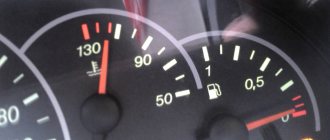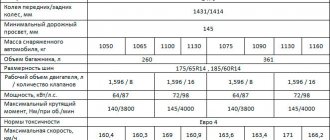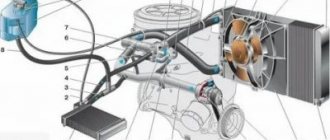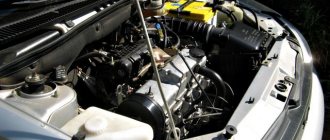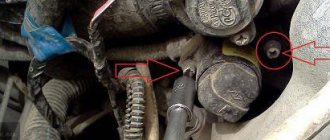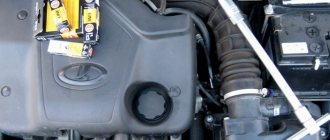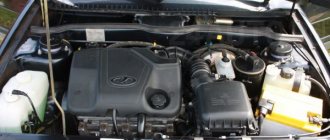You should monitor the engine temperature
Despite the high-quality assembly, the engine of each car can be subject to severe overheating. Many factors can lead to this outcome, especially high air temperatures during hot periods of the year.
Spare parts of the car engine and components interacting with it may fail, even if the permissible engine temperature has increased for a short time. Such situations must be warned in time to avoid unnecessary financial costs for updating parts. This means that you must always monitor the engine and its cooling system, eliminating any problems that arise.
The reasons for engine overheating in domestic cars can be either external or internal. Internal overheating poses the greatest threat because it is more difficult to detect. In such a situation, the antifreeze maintains its operating temperature, because the heat is present only inside the engine. In this case, the performance of the engine is greatly reduced, since the high temperature burns out the piston rings. As a result, this can lead to complete destruction of the motor from the inside.
The importance of using antifreeze
Monitor the antifreeze level
External engine overheating can occur for a number of reasons, and one of the main ones is insufficient antifreeze in the cooling system. Antifreeze can leak out easily because it has the structure of a regular liquid. Therefore, it is necessary to constantly monitor the integrity of the hoses and their fastenings.
Try to pay attention to the surface where the car has been standing for a long time. Light spots on it indicate a coolant leak. If such signs are detected, it is necessary to urgently check the integrity of all elements of the cooling system. If antifreeze leaks into one of the engine cylinders or into the oil compartment, serious complications are quite possible.
If you do not use antifreeze, but fill the cooling system with distilled water, you should not use hard water, which contains a large amount of minerals and salts. You risk ruining even a new thermostat after only 3-4 thousand kilometers.
Possible malfunctions of the ODS, diagnostics
Almost always, a breakdown of the cooling function of a car is caused by an antifreeze leak. You should inspect the car under the hood for possible leaks. The cause of the leak may be:
- or a leaky clamp;
- or a radiator failure.
Then in the first case the element is replaced; this is not difficult and does not take long. As for the radiator, it is better to have it repaired. There are also no particular difficulties here: often you just need to solder the holes.
The reasons for overheating of this car can also be:
- thermostat. Its suitability is checked using both pipes: the temperature of the latter should not be sharply different (this is determined on a warm engine). Otherwise, the thermostat is faulty and antifreeze circulates in a small circle;
- clogging of radiator honeycombs. You can solve the problem by cleaning the outside of this element. Often this is not always easy to do, but there are no other methods other than manually cleaning the honeycombs;
- Fan malfunction. When the heating level of the coolant increases, this part should begin to operate. If this does not happen, check the relay, wiring or t° sensor;
- air in the coolant system. Lada Kalina is not insured, among other things, against the so-called air lock inside the system. In general, previous types of breakdowns are eliminated quite quickly and almost everything is clear with them. In the latter case, it is necessary to understand in more detail. The question - how to remove air from the Kalina cooling system - is really very important for the optimal functioning of the totality of the elements of this car.
Causes of external overheating of the Kalina engine
Engine overheating can be caused by extremely low circulation of cold air inside the radiator. Most often this is due to the power supply to the ventilation system. In particular, the sensor that controls the speed of rotation of the blades fails. In this case, you need to check the degree of tension of the belt that connects the ventilation sensor and the crankshaft. If everything is in order with the belt drive, you need to pay attention to the level of contamination of the radiator and, if necessary, clean the unit. The above actions will be useless only if the radiator has completely outlived its useful life. In this case, the unit will need to be replaced with a new one.
Overheating can occur as a result of warping of the engine head seal or cylinder block lining. Other reasons: overheating or damage to the unit. If you do not contact a service station in time, there is a possibility of engine water hammer or crankshaft destruction.
The motor may overheat if the temperature sensor is faulty. Over time, sediment builds up in every cooling system, preventing the thermostat sensor from moving freely. Eventually it stops responding to the temperature level of the antifreeze inside the engine. In this case, the thermostat will circulate antifreeze through a small circuit, thereby reducing the cooling efficiency of the engine. This may not have any effect on the engine in the cold season, but in warmer weather the engine will overheat.
Another reason why the engine heats up may be excessive valve burnout. The fact is that the operation of the internal combustion engine is based on the principle of cyclical combustion of fuel, which passes processed gases through the hole in the exhaust valve. These gases have an elevated temperature, which affects the overall heating of the engine of domestic cars.
The Lada Kalina engine heats up very quickly when it is overloaded in certain situations. For example, a car is used as a means of towing another vehicle or trailer. In addition, during the warm season, many people go on vacation to mountainous areas. At high temperatures, lifting the vehicle will require increased torque, which is achieved at low speed. As a result, the cooling system reduces its efficiency and the engine overheats.
What to do if your car overheats in a traffic jam
When driving a car for a long time in a lower gear, the engine operates with increased power, which in itself leads to overheating. Add to this the lack of counter-flow of air necessary to cool the radiator. What to do? The main thing is not to panic. Short-term overheating is not terrible, but if you see that the car is not cooling down, it’s time to act.
Important - do not turn off the engine unless absolutely necessary. Exactly - without extreme. A stalled, overheated engine is an almost 100% guarantee of repair. It will take quite a long time to describe what is happening in the engine in this case (rotating the liners together with the crankshaft, when the engine is subsequently started - the least of the possible troubles), just take it on faith.
Important - do not think about pouring water on the engine or pouring cold water into the radiator. The result is the same - repair. Moreover, you can try so hard that you cannot do without replacing the block and cylinder head. Another “beauty” of cold water is microcracks inside the block. Finding and eliminating will be very, very difficult, if not impossible. The car has overheated - try to pull over to the side of the road. If it doesn’t work out, don’t panic and don’t pay attention to those around you – it’s important for you to save the engine. Stop at idle, turn the heater on full, and wait. If after 5-10 minutes the situation does not improve, turn off the engine. It’s a good idea to open the hood; the main thing in a panic is not to forget to set the car’s parking brake.
The only reason to turn off the engine right away is clouds of steam coming from under the hood. Most likely, the cooling pipe has burst, and further operation of the engine will only worsen the situation.
This is what it looks like, engine overheating, if you look closely. Now you know why the engine gets hot and how to deal with it. Author: Igor
Why does the engine get hot from the inside?
The consequences of external engine overheating are not as serious as internal ones, since the temperature sensor on the dashboard will definitely report the problem. You saw that the arrow crossed the acceptable mark and took action. With overheating from the inside, everything is much more complicated; most often it leads to serious problems.
During vehicle operation, sediment accumulates in certain engine parts, resulting from the use of low-quality fuel or oil. For this reason, the engine is usually overhauled and cleaned after a certain mileage. The sediment collects mainly in the cylinder head. If the engine is not cleaned in time, the sediment will form a seal with poor thermal conductivity. In this case, the antifreeze circulation circuits are blocked, the coolant loses its effectiveness, and the thermostat fails. As a result, the engine heats up, although you don’t notice it.
Circuits blocked by sediment increase the likelihood of cooling coating cavitation. Cavitation is the process of damage to the metal shell of the engine, which most often becomes the cause of its detonation. Often mechanics may confuse cavitation with corrosion, but they are not the same thing.
The fundamental factor in internal engine overheating is burning out of the compartments in the cylinder block. In this case, a dense layer of deposits forms in the compartments, which creates the effect of thermal insulation. Typically, such problems arise in domestic cars with high mileage, that is, the engine begins to eat up more oil. As a result, the motor consumes only some of the resulting lubricant, and the rest forms seals. As the mileage increases, the engine overheats more and more, and the car owner does not even notice this, since the temperature indicator on the instrument panel is within the normal range.
One of the most destructive factors contributing to engine overheating is the regular use of additives. They often cause the formation of a dense metal-ceramic layer on the surface of the pistons. This coating has extremely low thermal conductivity. The presence of this factor alone already guarantees engine detonation.
Recommendations for motor maintenance
It's better to prevent problems in advance
So, Lada Kalina requires competent and timely maintenance of the engine cooling system. It is necessary to constantly monitor the functioning of the belt drive, thermostat, ventilation cooling system, radiator, and also fill in a sufficient amount of antifreeze. In summer, it is better not to use low-quality gasoline, especially on long trips. In urban environments, you need to take into account the density of traffic on the streets and the level of air temperature.
When choosing antifreeze, you must remember that you cannot mix coolant from 2 different manufacturers. This is fraught with rapid wear of elements in the cooling system with further destruction of its parts. To prevent this situation, you need to choose the right brand of antifreeze. But first of all, you will need to determine what kind of coolant is used in your Kalina.
Heat
If the engine temperature is too high, then you need to look for the cause of the breakdown. May work poorly:
- thermostat,
- water pump,
- blower fan,
- the radiator is clogged,
- coolant leaks appear.
Driving with an engine that is constantly heating up is even more dangerous than driving with an engine that is not warm enough. Therefore, all causes of overheating must be eliminated in a timely manner.
The following two tabs change content below.
- About the author:
- Latest articles:
I am the editor-in-chief of the site. In our editorial office: Hyundai Accent, Hyundai Solaris, Hyundai Santa FE (turbo-diesel 2015). I now have a Lada Kalina LUX (98 horses). A car fanatic, he has owned both left and right hand drive cars. Robots, CVTs, mechanics. The only thing missing was DSG. But it will be soon.
Similar materials
Tags: Questions Lada KalinaLada Kalina
Reasons for engine heating
Cooling system assembly
Quite often you can come across the concept of engine overheating on the Lada Kalina. There are quite a few reasons and they are worth knowing if you want to carry out the repair yourself without resorting to the help of a car service.
The main reason why overheating occurs (4th error on the instrument panel) is a malfunction in the engine cooling system, as well as, in rare cases, accumulated errors in the engine control unit. So, let's look at the main reasons for overheating of the main power unit of the Lada Kalina:
- Clogged engine cooling radiator and cooling lines.
Diagram of the working thermostat. If there is a malfunction, it jams into a small circle, causing the car to become very hot.
Coolant sensor locations
Cleaning the cooling radiator from debris
All these elements are part of the cooling system, which can fail.
Heats up at idle
At idle, the engine gets hot, most likely due to a faulty thermostat or a clogged radiator. Therefore, the reason must be sought here. First, you need to replace the thermostat. This operation is carried out quite easily:
- Drain the coolant through the radiator drain plug.
The drain plug in the radiator is located at the bottom right
Thermostat disassembly diagram
Attention! The new thermostat comes with a gasket that must be installed. For normal manufacturers of spare parts, it is included with the part, so it is worth checking its presence in the box.
- We carry out the assembly in the reverse order.
- Fill in coolant.
Important! When replacing a thermostat, it is recommended to pour completely new fluid into the system, since the wedge of this element can be caused not only by wear of the part, but also by the loss of the physical and chemical properties of the coolant.
Pour coolant into the system through the expansion tank
We warm up the car to operating temperature and test whether the problem is resolved. If not, then you need to remove the cooling radiator, wash it and blow it out. Also, heating can be caused by insufficient liquid, so it’s worth looking to see if a pipe has burst somewhere or if liquid is leaking from the system.
conclusions
The causes and methods of elimination, heating of the Lada Kalina engine in different modes are considered. So, the main reason remains the thermostat and radiator, which can fail. All other problems are purely individual and are determined through diagnostics and dismantling. You should not allow the engine to overheat, as this can adversely affect the operation of the power unit or cause it to fail.
I went to the garden after work. And water, and walk the cat for the first time.
It was +30, I was driving with air conditioning. The engine gets hot in traffic jams (it’s been like this since new - with a perfectly clean radiator - they say this happens on all vases). And then I remembered that I wanted to write one thing that everyone probably already knows, but suddenly.
During a trip to the Pamir Highway, on ascents, the engine temperature confidently crawled up to 100 degrees, sometimes higher. I fought this in a simple old-fashioned way: I turned the stove on full blast. The windows are open, so, to put it mildly, it’s not cold, but here you also get extra toasty.
Yes, it certainly brought down the temperature, but not as quickly as we would like. It would be more accurate to say that it didn’t just knock her down, but basically did not allow her to grow further. She lost her way very badly. And at some point a simple thought came to me: the car has air conditioning. There are two radiators, two fans... In general, I continued driving with air conditioning - on difficult sections I always turned it on. And the fan cooling the air conditioner radiator, in my opinion, is noticeably more powerful than usual. The first time it turned on, I even put down a few bricks. The engine temperature drops very quickly.
Yes, the air conditioner takes some power. But our ECU is smart. When you press the gas to the floor, it automatically turns off the air conditioning. This can be clearly heard by the click of the relay and the fact that the stuffiness begins again. You let go a little - another click of the relay, and again it blows cold air.
Almost every motorist has come across the concept of engine overheating, but not everyone knows why it occurs. Also, in this article we will talk about how to avoid this phenomenon, correct malfunctions and consider the recommendations of experts and the experience of motorists.
Video about possible causes of engine overheating:
The video material will tell you about the reasons for engine heating, elimination methods and recommendations.

